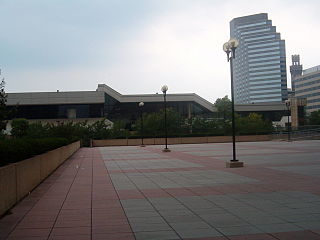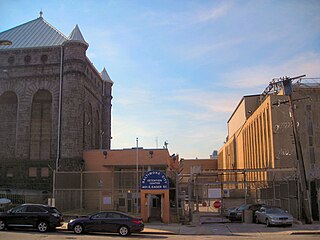
The Baltimore Convention Center is a convention and exhibition hall located in downtown Baltimore, Maryland. The center is a municipal building owned and operated by the City of Baltimore.

The West Virginia Division of Corrections and Rehabilitation is an agency of the U.S. state of West Virginia within the Department of Military Affairs and Public Safety that operates the state's prisons, jails and juvenile detention facilities. The agency has its headquarters in the state's capital of Charleston. Until July 1, 2018, the agency was simply the "West Virginia Division of Corrections" and only operated the adult prisons. On July 1, 2018 the agency absorbed the former West Virginia Division of Juvenile Services and the former West Virginia Regional Jail Authority and assumed its current name.

The Maryland Department of Public Safety and Correctional Services (DPSCS) is a government agency of the State of Maryland that performs a number of functions, including the operation of state prisons. It has its headquarters in Towson, Maryland, an unincorporated community that is also the seat of Baltimore County, Maryland, United States, located north of Maryland's largest city of Baltimore. Additional offices for correctional institutions supervision are located on Reisterstown Road in northwest Baltimore.

Capital punishment was abolished via the legislative process on May 2, 2013 in the U.S. state of Maryland.

Incarceration in the United States is a primary form of punishment and rehabilitation for the commission of felony and other offenses. The United States has the largest prison population in the world, and the highest per-capita incarceration rate. In 2018 in the US, there were 698 people incarcerated per 100,000; this includes the incarceration rate for adults or people tried as adults. In 2016, 2.2 million Americans have been incarcerated, which means for every 100,000 there are 655 who are currently inmates. Prison, parole, and probation operations generate an $81 billion annual cost to U.S. taxpayers, while police and court costs, bail bond fees, and prison phone fees generate another $100 billion in costs that are paid by individuals.

In criminal justice systems a youth detention center, known as a juvenile detention center (JDC), juvenile detention, juvenile hall, or more colloquially as juvie/juvy, also sometimes referred as observation home or remand home is a prison for people under the age of 21, often termed juvenile delinquents, to which they have been sentenced and committed for a period of time, or detained on a short-term basis while awaiting trial or placement in a long-term care program. Juveniles go through a separate court system, the juvenile court, which sentences or commits juveniles to a certain program or facility.

The Chesapeake Detention Facility (CDF), previously the Maryland Correctional Adjustment Center (MCAC), is a maximum level II prison operated by the Maryland Department of Public Safety and Correctional Services in Baltimore.

The Vernon C. Bain Correctional Center (VCBC), also known as the Vernon C. Bain Maritime Facility and under the nickname "The Boat", is an 800-bed jail barge used to hold inmates for the New York City Department of Corrections. The barge is anchored off the Bronx's southern shore, across from Rikers Island, near Hunts Point. It was built for $161 million at Avondale Shipyard in Louisiana, along the Mississippi River near New Orleans, and brought to New York in 1992 to reduce overcrowding in the island's land-bound buildings for a lower price. Nicknamed "The Boat" by prison staff and inmates, it is designed to handle inmates from medium- to maximum-security in 16 dormitories and 100 cells.

The GEO Group, Inc. (GEO), headquartered in Boca Raton, Florida, is a publicly traded real estate investment trust that invests in private prisons and mental health facilities in North America, Australia, South Africa, and the United Kingdom. The company's facilities include illegal immigration detention centers, minimum security detention centers, and mental-health and residential-treatment facilities. It also operates government-owned facilities pursuant to management contracts. As of December 31, 2019, the company managed and/or owned 95,000 beds at 129 facilities and provided community supervision services for more than 210,000 offenders and pretrial defendants. In 2019, agencies of the federal government of the United States generated 53% of the company's revenues.
The District of Columbia Department of Corrections (DCDC) is a correctional agency responsible for the adult jails and other adult correctional institutions for the District of Columbia, in the United States. DCDC runs the D.C. Jail.
The Louisiana Office of Juvenile Justice (OJJ) is a cabinet-level Louisiana state agency that provides youth corrections services in the state.
The Massachusetts Department of Youth Services (DYS) is a state agency of Massachusetts. Its Administrative Office is headquartered in 600 Washington Street Boston. The agency operates the state's juvenile justice services.

Occupy Baltimore was a collaboration that included peaceful protests and demonstrations. Occupy Baltimore began on October 4, 2011 in Baltimore, Maryland, in McKeldin Square near the Inner Harbor area of Downtown Baltimore. It is one of the many Occupy movements around the United States and worldwide, inspired by Occupy Wall Street.
The Texas Juvenile Justice Department (TJJD) is a state agency in Texas, headquartered in the Braker H Complex in Austin.
Baltimore, Maryland, U.S. is notorious for its significantly high crime rate, including a violent crime rate that ranks high above the national average. Violent crime spiked in 2015 after the death of Freddie Gray on April 19, 2015, which touched off riots and an increase in murders. The city recorded 348 homicides in 2019, a number second only to the number recorded in 1993 when the population was nearly 125,000 higher.

The Ellicott City Jail was the first detention facility in Howard County, Maryland.

Baltimore City Detention Center is a Maryland Department of Public Safety and Correctional Services state prison for men and women. It is located on 401 East Eager Street in downtown Baltimore, Maryland. It has been a state facility since July 1991.
Eager Street Academy is a public, alternative middle-high school serving youth who are incarcerated, located in the Penn-Fallsway neighborhood of Baltimore, Maryland, United States. The school was launched in 1998 as a collaboration between Baltimore City Public Schools (BCPSS), Maryland State Department of Education and the state's Division of Pretrial Detention and Services, and is a part of the larger city school system. Initially without an official name beyond its numeric designation, the school was given the name "Eager Street Academy" in 2002.

Incarceration in California spans federal, state, county, and city governance, with approximately 200,000 people in confinement at any given time. An additional 55,000 people are on parole.













